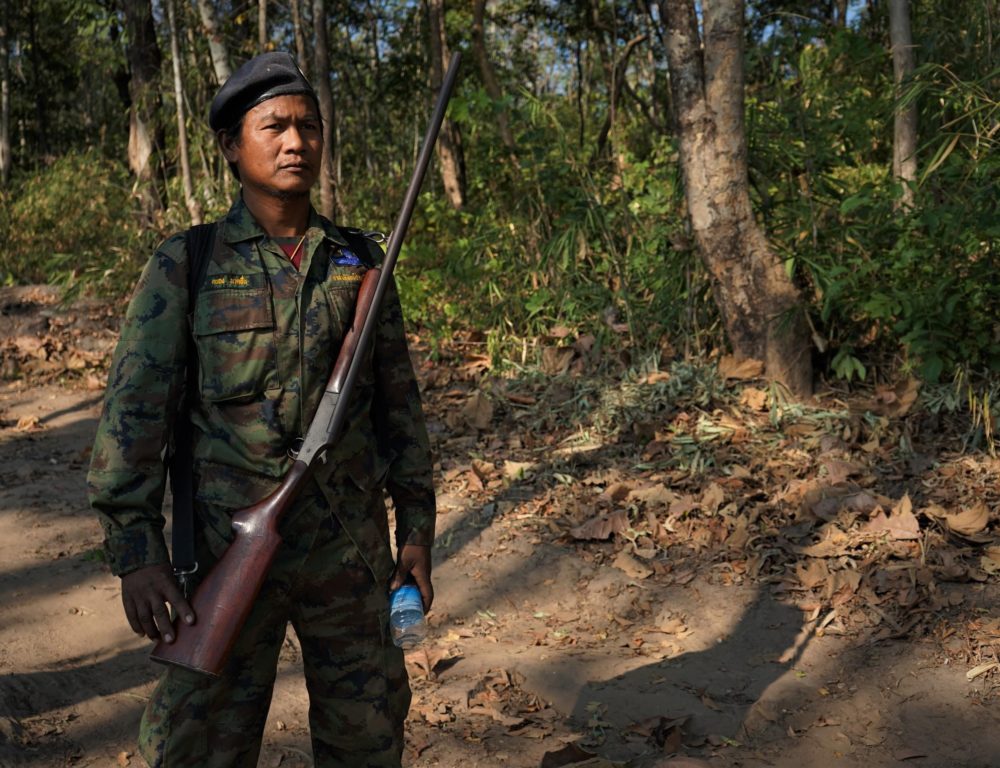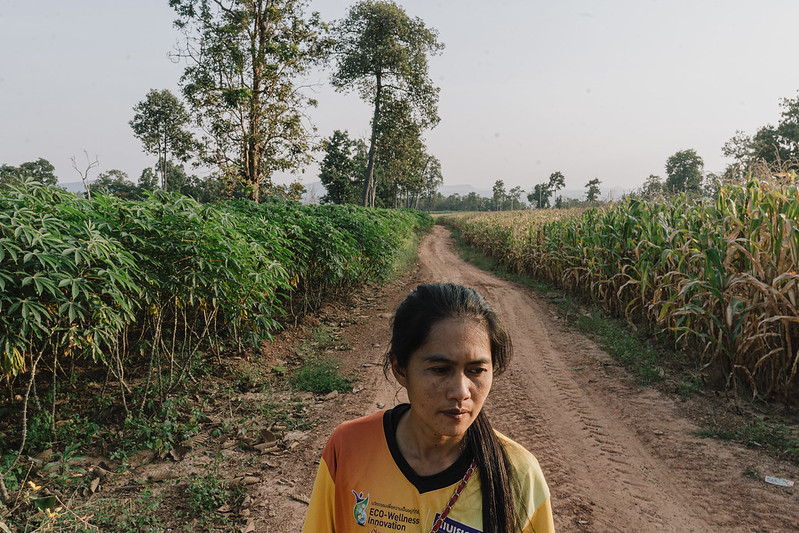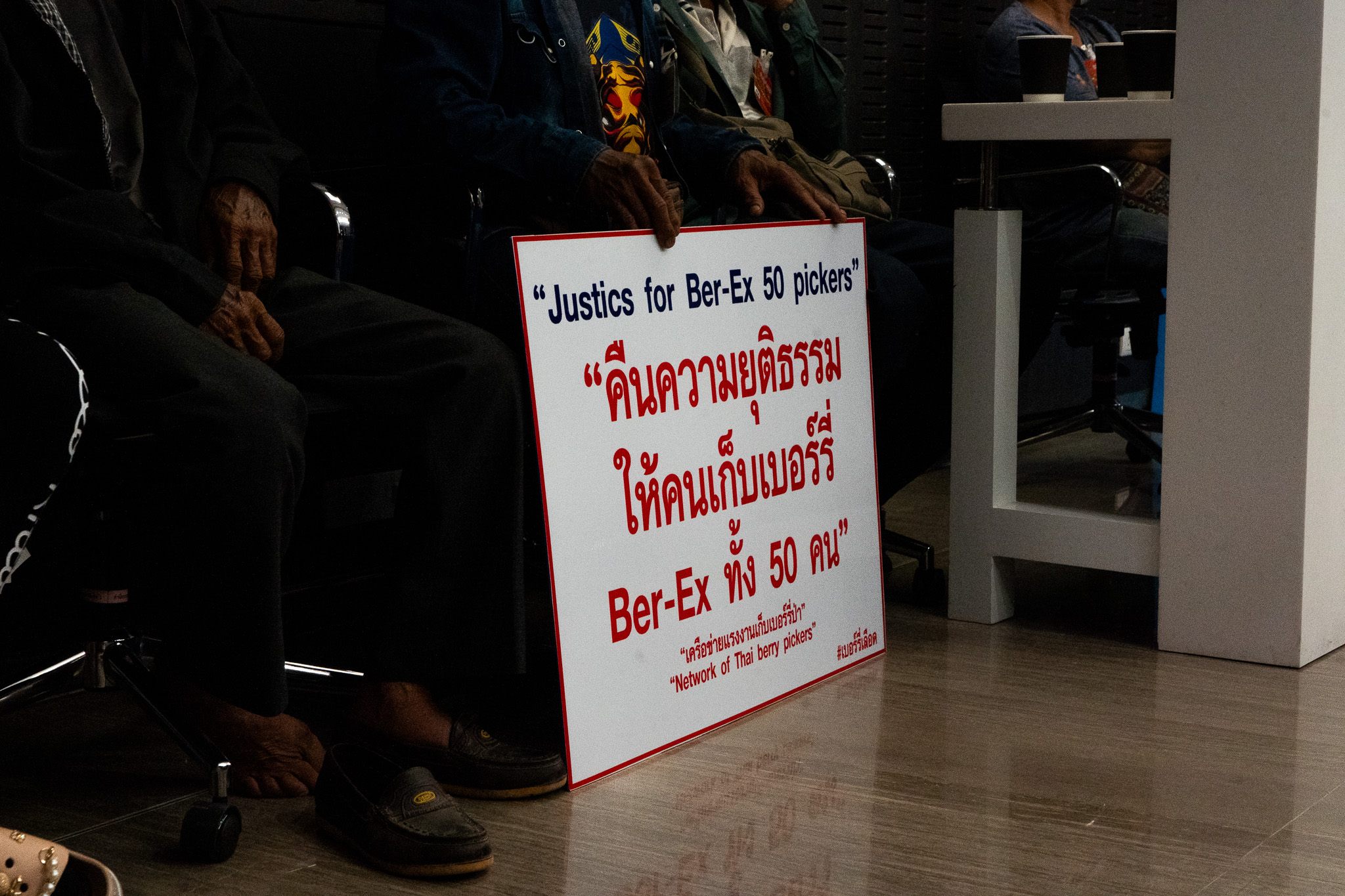In late 2012, a fire threatened to engulf the community forest of Huai Hin Kao village in Nong Khai’s Pho Tak district. Twenty local men followed the village chief’s call to help tackle the flames that came dangerously close to the community.
“I learned afterwards that the fire was caused by villagers cutting down trees to make way for rubber plantations,” says Khanong Nakchuen, who was one of the volunteers who helped put out the fire on that day. “They also burned leaves and branches when it was cold and windy, causing the fire to spread easily.”
The incident made Khanong and others in the village realize that their community forest was in urgent need of protection. They formed a group of volunteers to protect the forest that is now part of the Huai Hin Kao Forest Guardians Project.
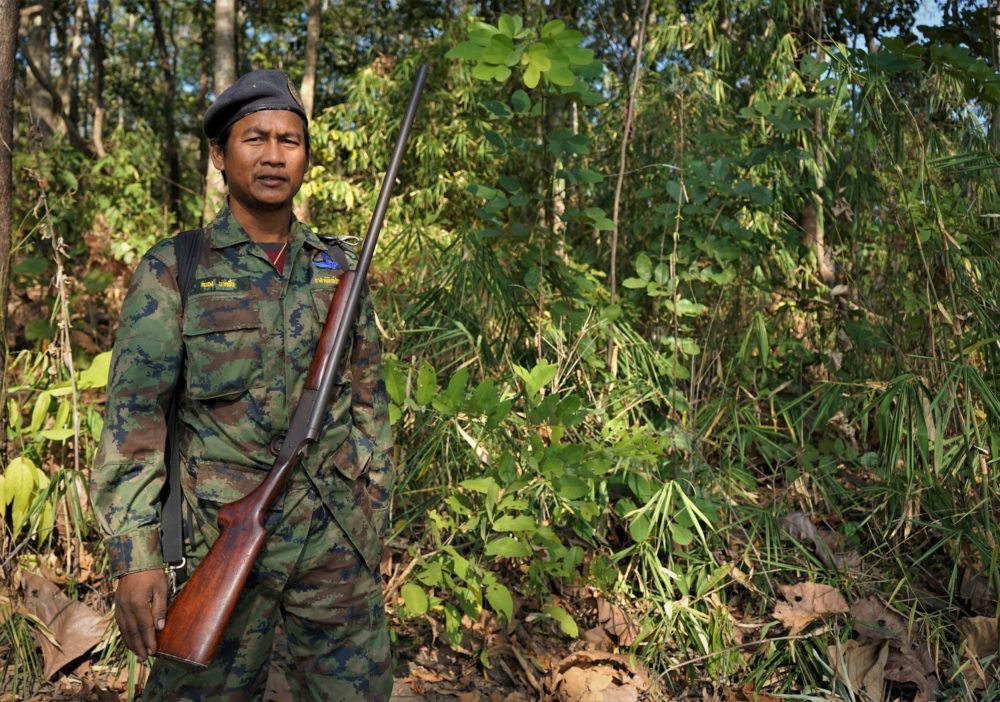
Khanong Nakchoen, a forest guardian on patrol in the Huai Hin Kao community forest in Phan Phrao National Park which borders the Mekong River.
The group became part of a project started in 1994 under the royal patronage of Queen Sirikit whose aim was to educate people about the importance of the country’s forests and to turn forest encroachers into forest guardians.
The Royal Forest Department provides training to protect natural resources and legal knowledge to communities who live close to forests. There are currently 7,606 volunteers participating in the project nationwide.
“We patrol the forest area under our responsibility to make sure make sure that no one cuts down protected trees and damages the forest. This is our main mission,” says Khanong, who is currently the deputy leader of the local Forest Guardians group.
Communities in the area depend on the forest as a source of food. For generations, people in Huai Hin Kao village have been collecting food, mainly mushrooms and bamboo shoots, in the forest, instead of buying them at the district market.
A minority of villagers also collect mushrooms and bamboo shoots for sale in the local market. Depending on the season and type of mushroom, villagers can make between 200 to 300 baht (about $6.4 to 9.6 USD) per kilogram. Selling fresh bamboo shoots can provide a family with an income of about 10,000 baht per month.
Forest guardians work to preserve the forest and prevent illegal logging of protected trees such as rosewood and padauk which are in demand and bring a high price. They also protect the forest ecosystem from damage by cassava, rubber, and pineapple farming operations.
“I decided to become a volunteer because I love this forest very much,” says Buntam Chatmuntree, one of six female volunteers in the group. “My mother’s family gets their food from the forest and has been earning money from selling non-timber forest products for more than 20 years.”
Buntam and the other female volunteers do not go on patrol trip for several days like their male counterparts. But she helps planting new trees and cooks for her colleagues.
“Apart from cooking, I go into the forest with the group and plant tree seedlings, but patrolling is the job of the male volunteers,” Buntam says.
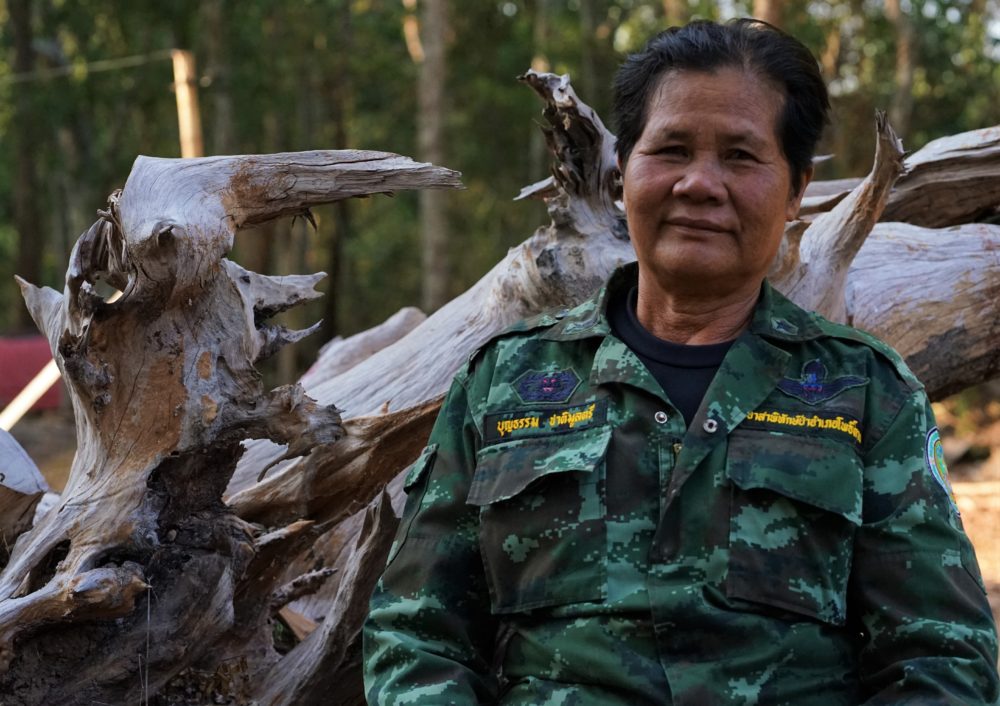
Buntam Chatmuntree is one of six female members of the Forest Guardians group who protect the community forest of Huai Hin Kao.
Boonsri Chatmuntree, the former village chief of Huai Hin Khao Village 6 founded the group and currently heads a network of forest guardians in Nong Khai Province, is proud of the group’s work. He says that since the Forest Guardian group was established eight years ago, many areas in the forest have recovered from illegal logging and forest clearing.
In the past, investors from outside the community would encroach on land for agricultural purposes. But since the volunteers and local officials began regularly patrolling the forest and investigating illegal landholdings, the forest has grown back.
“Apart from legal methods,” Boonsri says, “we also use local beliefs to help protect the forest, such as performing a tree ordination ceremonies in the forest.”
Thailand’s forests have been disappearing rapidly over the past six decades with currently about 31 percent of the country’s total landmass covered by forests. Compared to other regions, the Northeast has the lowest forested area with a forest cover of 15 percent according to a 2017 survey by the Forest Land Management Bureau.
In 2014, the military government led an aggressive campaign against “forest encroachers” purportedly aiming to reclaim forest areas and increase the country’s forest cover to 40 percent or more than 27.2 million rai (4.35 million hectares), a goal that was first set in 1975.
According to the Ministry of Natural Resources and Environment, between May 2014 and September 2018, the military’s forest reclamation campaign resulted in 28,000 lawsuits against forest encroachers, covering a total area of almost 820,000 rai (131,200 hectares).
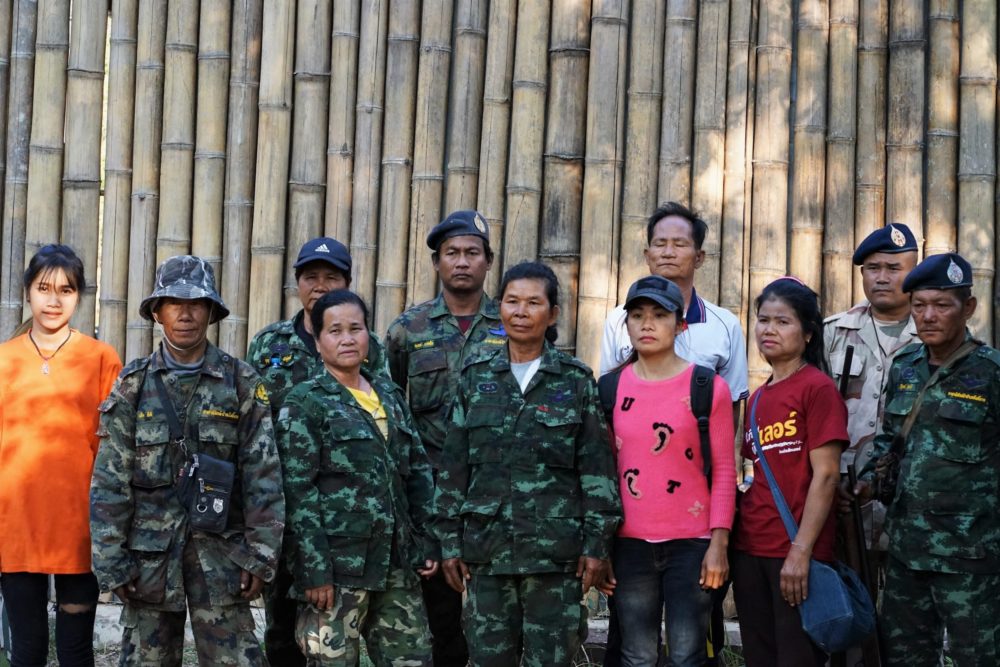
For eight years, the Forest Guardians have volunteered to protect the forest that many in their community depend on.
Leaving work to volunteer
All volunteers in the Huai Hin Kao group are locals, and most of them usually work in construction and on rubber plantations. Both Khanong and Buntam say they have to stop tapping rubber when they are asked to patrol the forest.
“Forest guardians do not receive any payment. It is a real volunteer job. Whenever a task comes up,” Khanong says, “I need to stop tapping rubber at night to go on patrol. It means, on that day, my family will lose over 400 baht, which is the same for other members.”
He is quick to point out that he is not asking for salary as he knew from the beginning that this was a volunteer position which does not include regular payment.
But he hopes the government could provide the volunteers with a modest compensation to support their families on days when their patrolling work keeps them for taking on paid work.
“We are not asking for the salary of [government] forest rangers who receive tens of thousands of baht,” Khanong says. “We only want a minimum wage so that there is money left to give to our families.”
One bullet a day
Khanong’s volunteer group has 20 members but the local administration only provides them with six firearms by order of the Royal Forest Department.
“Each time we go on patrol and sleep in the forest, volunteers carrying a firearm will receive only one bullet a day,” Khanong says. “I always worry about what would happen to us if we encountered an encroacher, who mostly carry assault weapons.”
The group had 12 firearms when it was founded. But when Boonsri left his position as village chief, the local administration asked him to return the firearms. He was lucky to be able to negotiate that the group could keep six rifles and shotguns to perform their duties.
“There is a shortage of weapons,” Boonsri says frankly. “Sometimes we don’t even have any bullets. Whenever we work together with the police, soldiers, or local administration officers, we will ask for one or two boxes of bullets so we can give out two or three bullets to each person.”
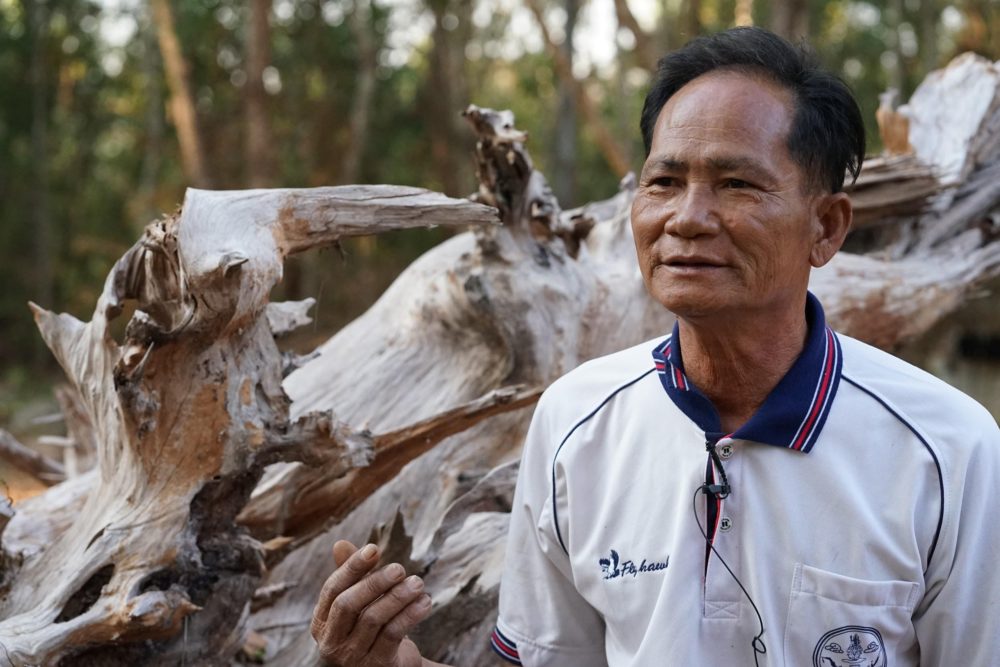
Boonsri Chatmuntree, the former village chief of Huai Hin Kao Village 6, who founded the Huai Hin Kao forest guardian group.
As the leader of the group, Boonsri says his first priority is to guarantee the safety of the members when on patrol. He is concerned that if there is an attack, they might not have enough bullets to defend themselves and might get hurt or die.
“Whenever there’s a clash with illegal loggers, I worry about what will happen to our wives and children if we get injured, end up disabled, or die,” Boonsri says. “How will our families be able to survive? Who will take care of them? There isn’t any social welfare for us.”
The Department of National Park, Wildlife, and Plant Conservation, however, does have a fund to compensate volunteers who get injured or die on duty. The fund provides 10,000 baht per person (about $321 USD) in the case of a death, while those injured are given up to 5,000 baht per person.
Apart from weapons, volunteers need shirts and pants for, for their multi-day patrols, along with boots, backpacks, and flashlights.
Getting uniforms has been a problem. Boonsri said in 2016 he requested uniforms for volunteers bearing the insignia of the Royal Forest Department. They did receive a single uniform for each member but the group had ask a local military unit to donate old uniforms.
Boonsri says the outcome created a piebald (or motley or variegated) appearance of their group. “The uniforms come in many colors and with different prints because they are the old worn ones from the military. A lot of volunteers still need more uniforms.”
Sutin Kotchompoo, director of the Nong Khai Provincial Office of Natural Resources and Environment told The Isaan Record that funding has already been approved for the Huai Hin Kao Forest Guardians. But the payout of the funds still need to go through the administrative process.
Despite the lack of social security and sufficient equipment, the Huai Hin Kao Forest Guardians are determined to continue protecting the forest that provides their families and other communities in the area with food.
Reporting by Yodsapon Kerdviboon. First published in Thai on 19 December 2019. Translated and edited by The Isaan Record.
